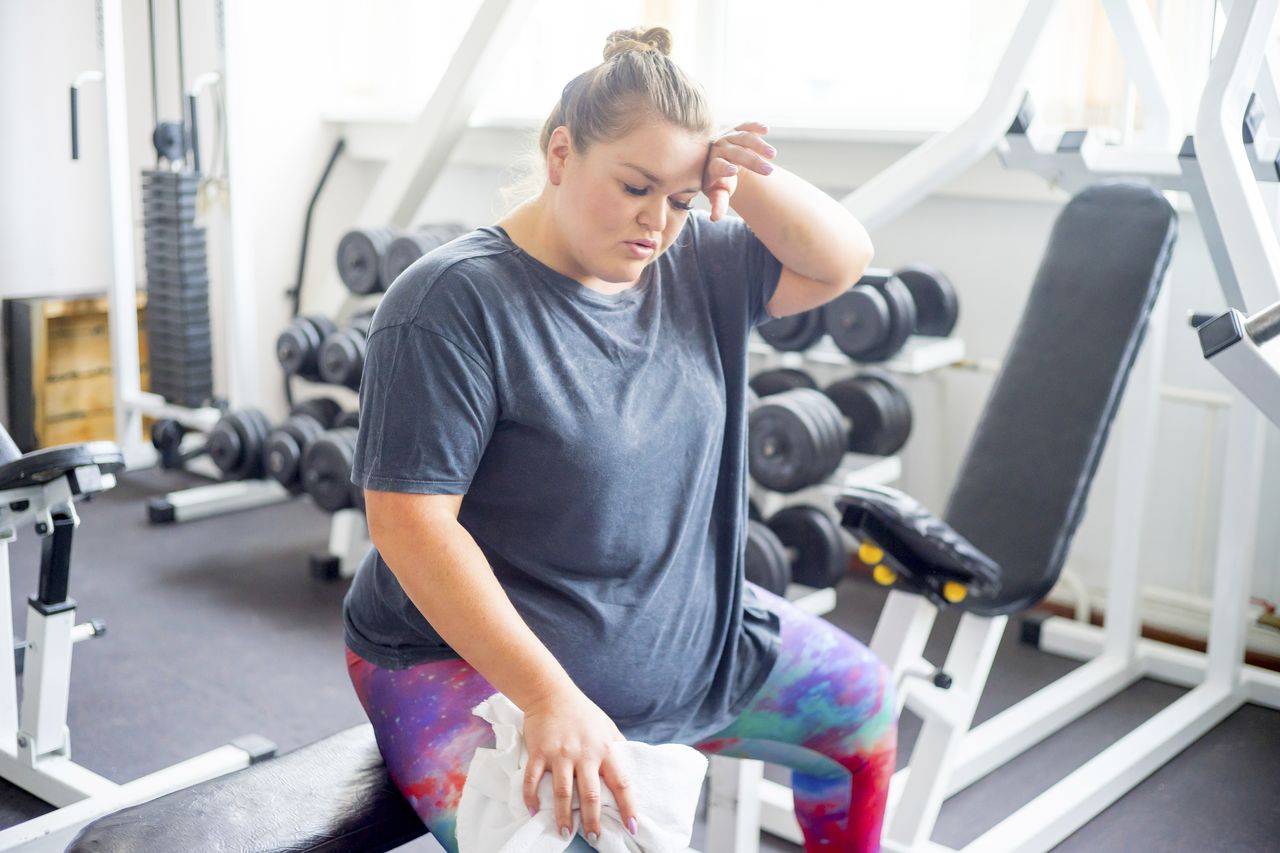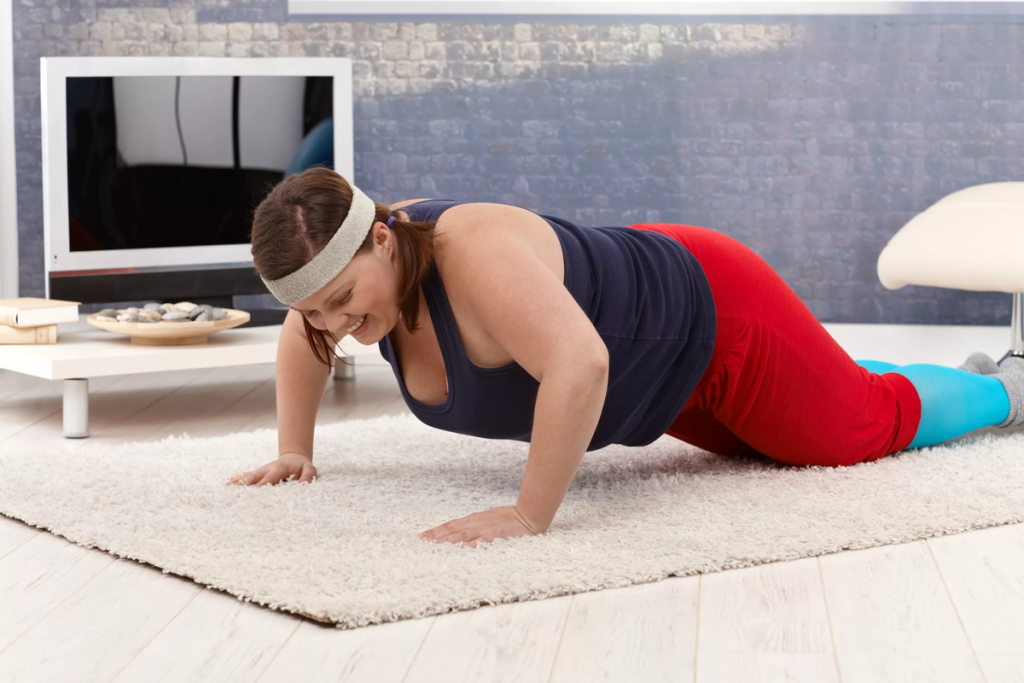Strength training can be a valuable tool in your weight loss toolkit. It can boost metabolism, increase energy, and even burn calories.
Strength training for weight loss focuses on building muscle mass, which can lead to increased metabolism and calorie burn even at rest.1 Unlike aerobic exercises that primarily target cardiovascular health, strength training helps sculpt and tone the body while promoting fat loss.2
This article reviews strength training exercises suitable for home workouts, considering different classes of weights tailored for both men and women.
What Strength Training Does for Weight Loss
Strength training, also called resistance training, is an anaerobic activity that offers several benefits for weight loss, including increased muscle mass, enhanced metabolism, improved body composition, and long-term fat burning.3 However, it does not directly burn as many calories during a workout as aerobic exercises.

Understanding how lean muscle mass relates to weight loss is necessary for grasping how the body works with exercise and diet.
Lean muscle mass is the weight of your muscles without extra fat. Muscle burns calories even when you’re inactive, boosting your metabolism and aiding in weight management. Strength training helps build muscle, improving your body’s ability to burn calories, reducing body fat, and improving overall fitness for better weight control.4
In a nutshell, having more lean muscle mass can increase your metabolism and may help you burn more calories throughout the day.
One 2022 review and meta-analysis of 114 clinical trials involving 4,184 participants found that:5
- Resistance exercises, such as lifting weights or using resistance bands, can help people lose fat and improve their health.
- Resistance exercises not only help reduce body fat but also preserve muscle mass.
- Combining resistance training with eating less can lead to significant weight loss and improve overall health, especially in older adults.
- Even without changing the diet, doing a mix of resistance and aerobic exercises can reduce belly fat and improve health, particularly for middle-aged and older adults.
While resistance training is not a magic solution, it’s an important part of a weight loss plan, along with eating healthier and being more active overall.
EXERCISES FOR OVERWEIGHT | OBESE PEOPLE. SET NO. 1: GENERAL EXERCISES TO STRENGTHEN MUSCLES AND IMPROVE JOINT MOBILITY
Home Strength Training for Burning Fat and Losing Weight
To start strength training at home, you may want to consider investing in some basic equipment. Start by finding a spot in your home for your workout area that can accommodate workout equipment such as:
- Dumbbells and kettlebells: These versatile free weights allow for a wide range of exercises targeting different muscle groups.6
- Resistance bands: These are like large rubber bands that provide resistance when stretched.6 They are beneficial for targeting muscles with varying intensity levels and can help improve muscular endurance.
EXERCISES FOR OVERWEIGHT/OBESE PEOPLE. SET NO. 2: POWER EXERCISES WITH A GYMNASTIC ELASTIC BAND/TERABAND
Body-Weight Exercises
Body-weight exercises are effective for building strength and muscle without the need for equipment. Here are some key body-weight exercises you can do at home:
Squats
This exercise targets the quadriceps, hamstrings, glutes, and core. To do this exercise:7
- Start in a standing position with feet slightly wider than hip-width apart.
- Lower your body by bending your knees and pushing your hips back, keeping your chest up and back straight.
- Lower yourself until your thighs are parallel to the floor or as low as comfortable.
- Push through your heels to return to the starting position.
This exercise targets the quadriceps, hamstrings, glutes, and core.
High Knees
This article helps your balance and improves endurance. To do this exercise:8
- Stand tall with your arms by your sides.
- Lift one knee as high as possible while quickly switching to lift the other knee, resembling a running motion.
- Engage your core and keep your back straight throughout.
Plank
The plank strengthens the core, improves posture, and enhances overall stability.9
- Start on your hands and knees with your wrists directly under your shoulders.
- Extend your legs behind you, balancing on your toes and forearms.
- Keep your body in a straight line from head to heels, engaging your core muscles.
- Hold this position for as long as possible, focusing on maintaining proper form.
Push-Ups
This exercise targets the chest, shoulders, triceps, and core muscles. To do a proper push-up:10
- Begin in a plank position, with your hands slightly wider than shoulder-width apart.
- Lower your body by bending your elbows until your chest nearly touches the floor, keeping your body in a straight line and keeping your elbows by your sides when bending them.
- Push through your palms to extend your arms and return to the starting position.
This exercise targets the chest, shoulders, triceps, and core muscles.
Lunges
Lunges work the quadriceps, hamstrings, and glutes and improve balance and stability. To do a lunge:11
- Stand with your feet hip-width apart.
- Step forward with one foot, bending both knees to lower your body until the front thigh is parallel to the floor.
- Keep your back straight and your torso upright throughout the movement.
- Push through the front heel to return to the starting position and repeat on the other side.
EXERCISES FOR OVERWEIGHT/OBESE PEOPLE. SET NO. 3: POWER EXERCISES WITH DUMBBELLS. WEIGHT IS SELECTED INDIVIDUALLY. IT IS RECOMMENDED TO START WITH 1-2 KG
At the Gym: Machines and Number of Reps
When working out at the gym, utilizing various machines can add versatility and target specific muscle groups. Here are some common types of machines and equipment you may encounter:
Strength Training Machines
Strength machines target specific muscle groups. They are suitable for beginners because they are safer and easier to control than free weights.12
Bench Press
The bench press is a common tool for chest exercises. When starting out, remember to start by using the bar and not pushing yourself to do too much too soon.13
Free Weights
Barbells, dumbbells, and kettlebells are versatile tools for strength training and functional movements that can be found at a gym.
The American Heart Association recommends strength-building activities a minimum of twice a week.14
Consider consulting with a certified fitness professional to learn proper techniques before starting a strength training program. Performing one set of eight to 12 repetitions until your muscles are fatigued is typically effective for each muscle group.14
As you build strength, gradually increase the weight or the number of days you engage in strength training. Adding more sets or increasing frequency can improve results.14
EXERCISES FOR OVERWEIGHT/OBESE PEOPLE. HYDROTHERAPY MODULE: SWIMMING AND HYDROTHERAPY, EXERCISES IN THE WATER
How Soon Does Strength Training Lead to Results?
The time frame for seeing results from strength training for weight loss varies based on individual factors like fitness level, consistency, diet, and exercise intensity.
Some research shows that after ten weeks of consistent resistance training, you might see an increase in lean body mass by 1.4 kilograms (kg) (about 3.1 pounds) and a 7% boost in your resting metabolic rate. Additionally, this training can lead to a reduction in fat weight by 1.8 kg (roughly 4 pounds).15
In addition, resistance training helps promote bone development, with research showing a 1% to 3% increase in bone density.15
Special Considerations and Precautions
Before beginning any exercise program, it’s important to talk with your healthcare provider and identify any medical conditions that might put you at risk during physical activity.
Safety precautions are essential, especially for individuals with chronic pain or health conditions. Gradual progression, proper warm-ups, and listening to your body’s signals are crucial.16
Summary
Incorporating strength training into a weight loss journey offers numerous benefits, including increased muscle mass, improved metabolism, and enhanced fat burning.
By combining home exercises, gym workouts, proper form, and safety precautions, individuals can achieve effective and sustainable weight loss results. It’s essential to approach strength training with consistency, patience, and a focus on overall health and wellness.

DEMO VERSION OF GRS WORKOUTS FOR REHABILITATION OF PATIENTS with obesity ON YOUTUBE
Our website presents sets of exercises for the rehabilitation of the patients with obesity in the following areas:
-
EXERCISES FOR OVERWEIGHT/OBESE PEOPLE. SET NO. 1: GENERAL EXERCISES TO STRENGTHEN MUSCLES AND IMPROVE JOINT MOBILITY
-
EXERCISES FOR OVERWEIGHT/OBESE PEOPLE. SET NO. 2: POWER EXERCISES WITH A GYMNASTIC ELASTIC BAND/TERABAND
-
EXERCISES FOR OVERWEIGHT/OBESE PEOPLE. SET NO. 3: POWER EXERCISES WITH DUMBBELLS. WEIGHT IS SELECTED INDIVIDUALLY. IT IS RECOMMENDED TO START WITH 1-2 KG
-
EXERCISES FOR OVERWEIGHT/OBESE PEOPLE. HYDROTHERAPY MODULE: SWIMMING AND HYDROTHERAPY, EXERCISES IN THE WATER






